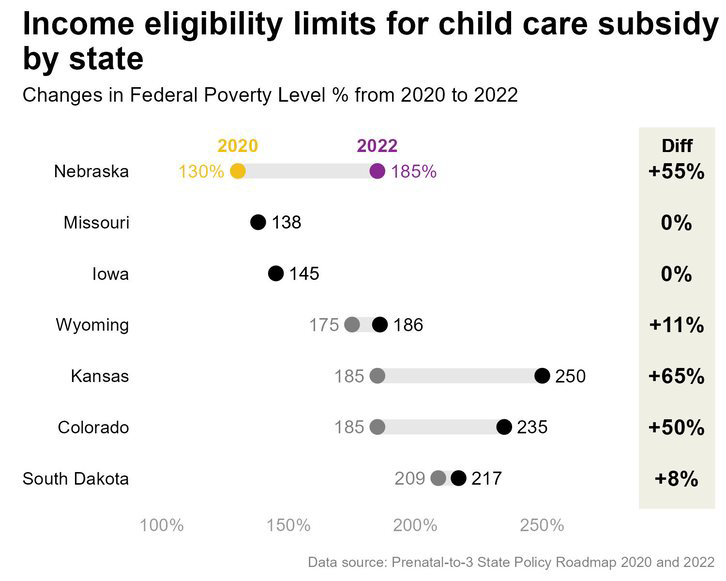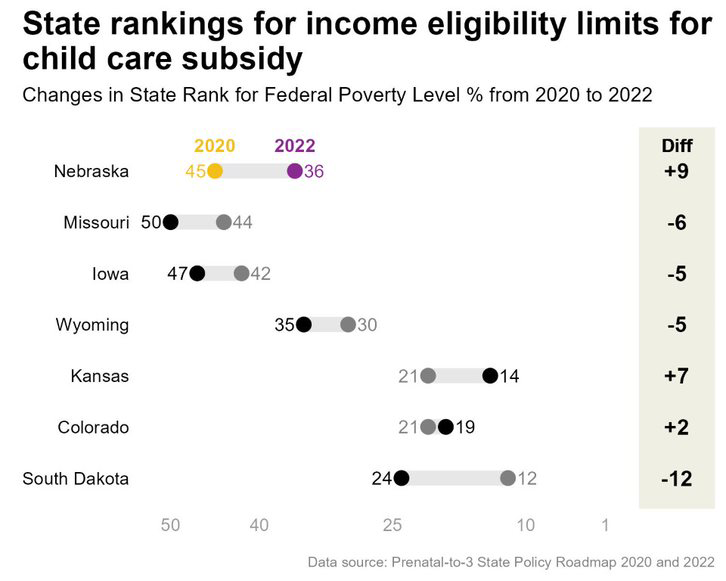At First Five Nebraska, we value public policy that is grounded in research. It informs which policies we support. We stay apprised of research in the early childhood field to be a resource for policymakers in Nebraska. And we pursue research projects like The Bottom Line: Economic Impacts of Inadequate Child Care Access in Nebraska and LR162: Efficacy of the School Readiness Tax Credit to inform the early childhood public policy conversation in our state.
It is through this policy research lens that we became involved in studying the impact of LB485. Passed by the Nebraska Legislature in 2021, LB485 expanded the income eligibility requirement for the child care subsidy from 130% of the Federal Poverty Level (FPL) to 185% FPL at initial application. LB485 also expanded access to transitional child care subsidy for families whose financial situation improved at the end of their authorization period. To be eligible at redetermination, the income limit for child care subsidy increased from 185% FPL to 200% FPL. Ostensibly, this change in the income threshold will increase the number of families who can enroll in the program and receive financial support for child care expenses while they are at work or pursuing their education.
LB485 required an impact study to evaluate the effects of the changes. First Five Nebraska, in partnership with the Nebraska Department of Health and Human Services (NDHHS) and in collaboration with researchers from the University of Nebraska–Lincoln Bureau of Business Research and the National Institute for Early Education Research, is leading the impact study efforts.
Child care subsidies—what we already know
First Five Nebraska supported the LB485 legislation because research shows that the child care subsidy positively affects families with low income by improving parental employment, particularly mother’s employment, and directly increasing the resources families have available to them for their needs. [1] The same research also shows access to high-quality child care supports positive brain development, and increasing the income eligibility criteria will allow more families to seek out high-quality care environments.
Child care subsidy—what we hope to learn
Although current research tells us that access to subsidies has benefits to families, the federal government allows states significant flexibility in how they implement the child care subsidy program. in how they implement the child care subsidy program. Therefore, there is less agreement on whether specific program policies are better or worse at achieving these overall benefits.
One of the policies that varies from state to state is eligibility criteria, including the income level at which families qualify. This is what makes the LB485 Impact Study so important, not just for Nebraska, but to contribute to the national conversation around best practices in eligibility.
Child care subsidy in Nebraska
Nebraska’s income eligibility for child care subsidy was 185% of the Federal Poverty Level until 2002 when it was lowered to 120% FPL by a Governor line-item veto. In 2013, eligibility was increased to 130% FPL. For nearly 20 years prior to passage of LB485, Nebraska had some of the most restrictive income requirements in the nation to qualify for child care subsidy benefits. [2]

 Note: FPL percentages for 2020 values are noted in yellow (Nebraska) and gray (surrounding states), and 2022 values are noted in purple (Nebraska) and black (surrounding states). Data retrieved from the Prenatal-to-3 State Policy Roadmap for 2020 [2] and 2022 [3].
Note: FPL percentages for 2020 values are noted in yellow (Nebraska) and gray (surrounding states), and 2022 values are noted in purple (Nebraska) and black (surrounding states). Data retrieved from the Prenatal-to-3 State Policy Roadmap for 2020 [2] and 2022 [3].
Understanding the impact of eligibility changes
The impact of the LB485 legislation can be measured in several different ways. The impact study will consider if:
- More children have access to safe, reliable early learning environments.
- Parents and families using the child care subsidy program have greater financial stability and have a clear path to economic security without an outsized benefits cliff.
- Labor force participation changes for parents using the child care subsidy.
- Local communities and the State of Nebraska experience economic benefits or losses.
Understanding the impact will take a multi-tiered approach. We are working with NDHHS to understand the child care subsidy program data, including the economic implications of that data for families and the state. We are talking to parents and guardians, child care professionals and community members about how they are experiencing the changes to the child care subsidy program in their everyday lives. And we are interpreting all of this within the context of the child care subsidy as a whole by reviewing state and federal law and regulations and their practical applications.
Future of child care subsidy in Nebraska
It’s important to know that LB485 contains sunset language that says the income eligibility criteria will revert to 130% FPL on October 1, 2023. However, LB227, which is on Final Reading in the Nebraska Legislature, will change the sunset date to October 1, 2026, if it’s passed and signed by the Governor. LB227 also changes the date the impact study is due to the Legislature from December 15, 2023, to July 1, 2024. The impact study is designed to provide state senators with information to make an informed decision on income eligibility criteria for the child care subsidy program. If the impact study demonstrates a benefit to Nebraska families, communities and the state, the Nebraska Legislature may consider making the eligibility changes permanent.
Over the next few months, First Five Nebraska will be talking to those most affected by changes in the child care subsidy program. To learn more or participate in the discussions, please follow the links below:
- Child Care Providers, May and June 2023 | Learn more | Sign-up
- Parents and Guardians, June and July 2023 | Learn more | Sign-up
- Community Members, August 2023 | Learn more| Sign-up
We know the data is vital to understanding the impact of the changes to the income eligibility requirements for child care subsidy, but so are the stories of the people who are most affected by these changes. We are excited to engage with Nebraskans, to represent their lived experienced and to share the results of the impact study in the near future.
Read more about the LB485 Impact Study
_________________
[1] Prenatal-to-3 Policy Impact Center. (2022). Prenatal-to-3 policy clearinghouse evidence review: Child care subsidies (ER 07C.1022). Peabody College of Education and Human Development, Vanderbilt University. http://pn3policy.org/policy-clearinghouse/child-care-subsidies
[2] Prenatal-to-3 Policy Impact Center. (2020). Prenatal-to-3 state policy roadmap 2020: Building a strong and equitable prenatal-to-3 system of care. https://pn3policy.org/pn-3-state-policy-roadmap/complete-roadmap/
[3] Prenatal-to-3 Policy Impact Center. (2022). 2022 Prenatal-to-3 state policy roadmap. https://pn3policy.org/pn-3-state-policy-roadmap-2022/



